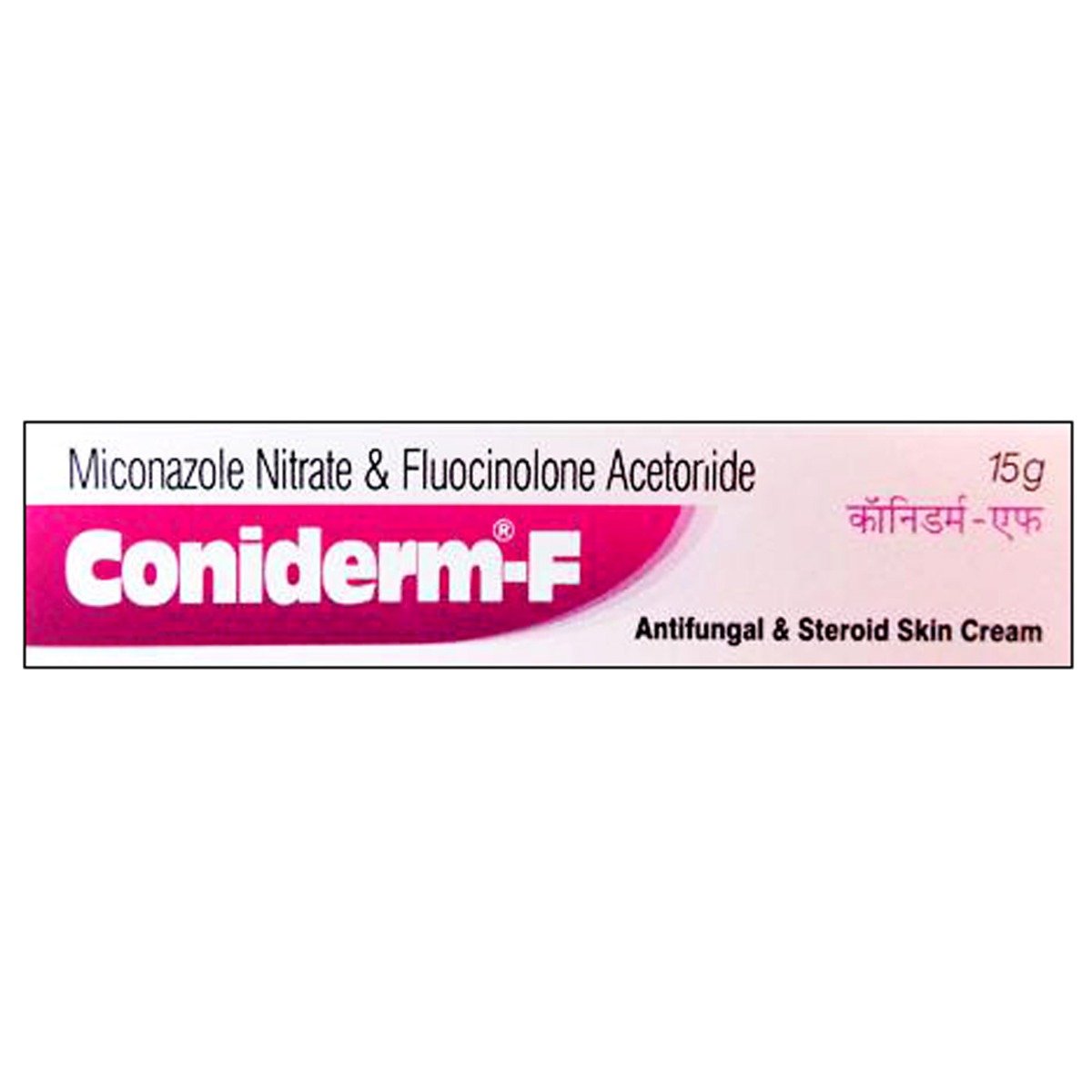Coniderm-F Cream 15 gm


MRP ₹129
(Inclusive of all Taxes)
₹19.4 Cashback (15%)
Selected Pack Size:15 gm
15 gm ₹116.1
(₹7.74 per gm)
Out of stock
20 gm ₹122.9
(₹6.15 per gm)
In Stock
Provide Delivery Location
Online payment accepted
 Prescription drug
Prescription drugWhats That
Composition :
Manufacturer/Marketer :
Consume Type :
Expires on or after :
Return Policy :
About Coniderm F Cream
Coniderm F Cream is a dermatological combination medicine used to treat fungal skin infections and their symptoms, such as swelling/inflammation, itching and redness. Fungal infection is a skin disease in which a fungus attacks the tissue and causes infection. Fungal infections may be contagious (spread from one person to another).
Coniderm F Cream is a combination of two drugs, namely: Fluocinolone acetonide (corticosteroid) and Miconazole nitrate (antifungal). Fluocinolone acetonide belongs to the class of corticosteroids that works by preventing the release of certain chemical messengers in the body that cause redness, itching, and swelling. On the other hand, Miconazole nitrate belongs to the class of antifungals that works by damaging the fungal cell membranes thereby killing the fungi.
Coniderm F Cream is for external use only. Use Coniderm F Cream as advised by your doctor. You are advised to use Coniderm F Cream for as long as your doctor has prescribed it based on your medical condition. Some people may experience dry skin, skin peeling, increased hair growth, pimples, patches of pale skin, itching, irritation, or a burning sensation at the site of application. Most of these side effects of Coniderm F Cream do not require medical attention and gradually resolve over time. However, if the side effects persist or worsen, please consult your doctor.
If you are known to be allergic to Coniderm F Cream or any other medicines, please tell your doctor. If you are pregnant or a nursing mother, it is advised to consult a doctor before using Coniderm F Cream. Do not use Coniderm F Cream in more than prescribed doses or for a prolonged time as it may cause adverse effects such as skin thinning, small visible veins, or stretch marks. Avoid using Coniderm F Cream for more than 5 days on the face. Do not apply Coniderm F Cream on open wounds, cuts, scrapes, or damaged skin. If you have rosacea (redness and often red, small, pus-filled bumps on the face), acne, perioral dermatitis (red, bumpy rash around the mouth), any skin infection, psoriasis, diabetes, liver or adrenal gland problems, inform your doctor before using Coniderm F Cream.
Uses of Coniderm F Cream
Directions for Use
Key Benefits
Coniderm F Cream contains Fluocinolone acetonide and Miconazole nitrate used to reduce swelling, itching, and redness caused due to fungal skin infections. Fluocinolone acetonide is a corticosteroid that acts inside skin cells and inhibits the release of certain chemical messengers in the body that cause redness, itching, and swelling. Miconazole nitrate is an antifungal that damages the fungal cell membranes which are essential for their survival as they prevent the entry of unwanted substances into the cells and stop the leakage of cell contents and kill fungi. Thereby, Coniderm F Cream clears fungal infections and provides relief from cracking, burning, scaling, and itching of the skin caused due to infections.
Storage
Drug Warnings
If you are known to be allergic to Coniderm F Cream or any other medicines, please tell your doctor. If you are pregnant or a nursing mother, it is advised to consult a doctor before using Coniderm F Cream. Do not use Coniderm F Cream in more than prescribed doses, or for a prolonged time as it may cause adverse effects such as skin thinning, visible small veins or stretch marks. Avoid using Coniderm F Cream for more than 5 days on the face. Do not apply Coniderm F Cream on open wounds, cuts, scrapes or damaged skin. Do not swallow Coniderm F Cream. In case of accidental swallowing, contact a nearby poison control centre or consult a doctor immediately. If you have rosacea (redness and often red, small, pus-filled bumps on the face), acne, perioral dermatitis (red, bumpy rash around the mouth), any skin infection, psoriasis, diabetes, liver or adrenal gland problems, inform your doctor before using Coniderm F Cream.
Diet & Lifestyle Advise
- Regularly change your socks and wash your feet. Avoid shoes that make your feet sweaty and hot.
- In wet places such as changing rooms and gym showers, do not walk barefoot to prevent fungal infections.
- Do not scratch the affected area of the skin as it can spread the infection to other body parts.
- Avoid sharing towels, combs, bedsheets, shoes or socks with others.
- Wash your bed sheets and towels regularly.
Side Effects of Coniderm F Cream
- Dry skin
- Skin peeling
- Increased hair growth
- Pimples
- Patches of pale skin
- Itching, irritation or burning sensation at the site of application
Habit Forming
Therapeutic Class
All Substitutes & Brand Comparisons
Author Details
We provide you with authentic, trustworthy and relevant information
FAQs
Coniderm F Cream contains Fluocinolone acetonide and Miconazole nitrate. Fluocinolone acetonide works by preventing the release of certain chemical messengers in the body that cause redness, itching, and swelling. Miconazole nitrate damages the fungal cell membranes that are essential for their survival as they prevent the entry of unwanted substances into the cells and stop the leakage of cell contents and kills fungi. Thereby, Coniderm F Cream clears fungal infections and provides relief from cracking, burning, scaling, and itching of the skin caused due to infections.
Coniderm F Cream is not recommended to treat acne as it may worsen the condition. Coniderm F Cream is only used to reduce itching, swelling and redness caused due to certain skin infections. However, please consult a doctor if you have any concerns.
Coniderm F Cream should be used with caution in children above one year of age if prescribed by a doctor as Coniderm F Cream contains a steroid and may increase the risk of Cushing’s syndrome, HPA axis suppression (suppression of inflammatory and immune responses), adrenal insufficiency, delayed growth and weight gain. However, please consult a doctor before using Coniderm F Cream in children.
You are recommended to use Coniderm F Cream for as long as your doctor has prescribed it. However, if the condition persists or worsens after 2 weeks of treatment with Coniderm F Cream, please consult a doctor.
Coniderm F Cream is not indicated to treat diaper rash or itching around the genital area as using Coniderm F Cream under child’s nappy enables Coniderm F Cream to pass through the skin easily and causes adverse effects. However, please consult a doctor before using Coniderm F Cream in children.
Fungal infection is a contagious skin condition which spreads from one person to another through direct skin to skin contact or by contact with contaminated soil, surfaces or infected animals. Therefore, it is recommended to avoid close direct contact until the infection is clear and avoid sharing things with the infected person as it can also spread the infection.
Drug-Drug Interactions Checker List
- ANISINDIONE
- WARFARIN
- DICOUMAROL
Disease/Condition Glossary
Fungal infection: It is a skin disease in which a fungus attacks the tissue and causes infection. Fungal infections may be contagious (spread from one person to another). The symptoms of a fungal infection include scaly skin, blisters, itching, swelling, irritation, and redness.

Have a query?
Buy best Skin Disorders products by
Sun Pharmaceutical Industries Ltd
Glenmark Pharmaceuticals Ltd
Cipla Ltd
Oaknet Healthcare Pvt Ltd
Ranbaxy Laboratories Ltd
Salve Pharmaceuticals Pvt Ltd
Torrent Pharmaceuticals Ltd
Dr Reddy's Laboratories Ltd
Karlin Pharmaceuticals & Exports Pvt Ltd
Merck Ltd
Micro Labs Ltd
Abbott India Ltd
Alkem Laboratories Ltd
East West Pharma India Pvt Ltd
Intas Pharmaceuticals Ltd
Leeford Healthcare Ltd
Mohrish Pharmaceuticals Pvt Ltd
P and P Dermaceuticals Pvt Ltd
Surecare Pharma Pvt Ltd
Wockhardt Ltd
Canixa Life Sciences Pvt Ltd
Geno Pharmaceuticals Pvt Ltd
GlaxoSmithKline Pharmaceuticals Ltd
Apex Laboratories Pvt Ltd
Dabur India Ltd
Fourrts India Laboratories Pvt Ltd
Fulford India Ltd
Indi Pharma Pvt Ltd
Lupin Ltd
Mankind Pharma Pvt Ltd
Monichem Healthcare Pvt Ltd
Novartis India Ltd
NuLife Pharmaceuticals
Saf Fermion Ltd
Wallace Pharmaceuticals Pvt Ltd
A. Menarini India Pvt Ltd
Acme Corporation
Ajanta Pharma Ltd
Alembic Pharmaceuticals Ltd
An Pharmaceuticals Pvt Ltd
Apple Therapeutics Pvt Ltd
Biocon Ltd
Comed Chemicals Ltd
Dwd Pharmaceuticals Ltd
Dynamic Techno Medicals
E Merck India Ltd
H&H Pharmaceuticals Ltd
Hegde & Hegde Pharmaceutica Llp
Kaizen Pharmaceuticals Pvt Ltd
Klm Laboratories Pvt Ltd
Kremoint Pharma Pvt Ltd
Liva Health Care Ltd
Macleods Pharmaceuticals Ltd
Menarini India Pvt Ltd
Shalaks Pharmaceuticals Pvt Ltd
Stedman Pharmaceuticals Pvt Ltd
Unichem International
Yash Pharma Laboratories Pvt Ltd
Zee Laboratories Ltd
Adonis Laboratories Pvt Ltd
Alive Pharmaceutical Pvt Ltd
Amwill Healthcare Pvt Ltd
Apple Pharmaceuticals
Athens Labs Ltd
Aventis Pharma
Bayer Corporation
Bayer Pharmaceuticals Pvt Ltd
Bellissa Pharmaceuticals Pvt Ltd
Biochem Pharmaceutical Industries Ltd
Bion Therapeutics (I) Pvt Ltd
Blue Cross Laboratories Pvt Ltd
Cadila Healthcare Ltd
Cadila Pharmaceuticals Ltd
Centaur Pharmaceuticals Pvt Ltd
Concept Pharmaceuticals Ltd
Corona Remedies Pvt Ltd
Cosme Healthcare
DR Johns Lab Pharma Pvt Ltd
Dan Laboratories
Dermocare Laboratories Gujarat Llp
Dollar Company Pvt Ltd
Elder Pharmaceuticals Ltd
Emcee Pharmaceuticals (P) Ltd
Eskon Pharma
FDC Ltd
Fem Care Pharma Ltd
Finn Cosmeceutical Pvt Ltd
Galaxus Pharmaceuticals
Galaxy Biotech
Galderma India Pvt Ltd
Gary Pharmaceuticals Pvt Ltd
Gland Pharma Ltd
Gopish Pharma Ltd
Grefith Life Sciences Pvt Ltd
Ind Swift Laboratories Ltd
Indus Life Sciences Pvt Ltd
Insula Pharmaceuticals Pvt Ltd
Intermed Pharma Pvt Ltd
Intra Labs India Pvt Ltd
Janssen Pharmaceuticals Pvt Ltd
Alcohol
Safe if prescribed
Interaction of Coniderm F Cream with alcohol is unknown. Please consult a doctor before consuming alcohol while using Coniderm F Cream.
Pregnancy
Consult your doctor
Please consult a doctor. Coniderm F Cream is given to a pregnant woman only if the doctor thinks the benefits outweigh the risks.
Breast Feeding
Consult your doctor
It is unknown whether Coniderm F Cream is excreted in human milk. Please consult a doctor before using Coniderm F Cream while breastfeeding.
Driving
Safe if prescribed
Coniderm F Cream usually does not affect your ability to drive or operate machinery.
Liver
Consult your doctor
If you have any concerns regarding the use of Coniderm F Cream in patients with Liver problems, please consult a doctor.
Kidney
Consult your doctor
If you have any concerns regarding the use of Coniderm F Cream in patients with Kidney problems, please consult a doctor.
Children
Safe if prescribed
Coniderm F Cream is not recommended for children below 1 year. However, Coniderm F Cream should be used with caution in children above 1 year if prescribed by a doctor.




_0.jpg?tr=q-85)
